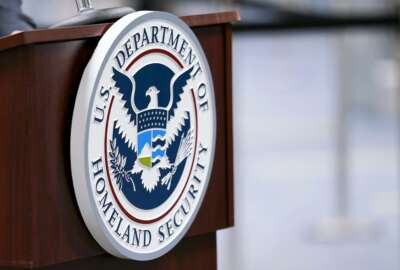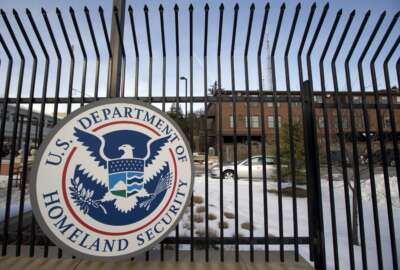Hubbard Radio Washington DC, LLC. All rights reserved. This website is not intended for users located within the European Economic Area.
While the elves prepare for Christmas, ICE is on the hunt for holiday scams
Each year the holiday buying season brings in a raft of phony and counterfeit goods into the country. And each year Immigration and Custom Enforcement's Intelle...
Best listening experience is on Chrome, Firefox or Safari. Subscribe to Federal Drive’s daily audio interviews on Apple Podcasts or PodcastOne.
Each year the holiday buying season brings in a raft of phony and counterfeit goods into the country. And each year Immigration and Custom Enforcement’s Intellectual Property Rights Coordination Center works to stop them. On Federal Drive with Tom Temin with this year’s update, the deputy director of the center, Ricardo Mayoral.
Interview transcript:
Tom Temin: Mr. Mayoral, good to have you on.
Ricardo Mayoral: Morning Tom, great to be here.
Tom Temin: So these fake properties — it’s watches and handbags and all kinds of stuff that comes in every year — how is it that you are able to determine what is counterfeit, when containers are stacked to the sky in all of the nation’s ports these days?
Ricardo Mayoral: The first thing we do is we partner with Customs and Border Protection to provide them with targeting data and targeting criteria to better sort among the millions of cargo containers that are coming in every day to our country, right. And the millions of pieces of mail that come into our country, right, to circle and sort, you know, between the legitimate commerce and materials that are coming into the U.S. and try to differentiate between the legitimate products and the counterfeit and pirated goods. So we work hand in hand with them to specifically try to build targeting criteria to identify, interdict and seize those goods. And out of those interdictions then, in hand with CBP, that information, those leads, are then passed to ICE Homeland Security investigations so then we can further and start investigating, you know, the manufacturers, the suppliers, entire chain of supply that brought back counterfeit pirated goods into the U.S.
Tom Temin: And if I’m a French or Italian, say, luxury products manufacturer with one of the famous names, and you know, I’m going to ship things to the United States, and that’s easy to trace, and you can discover the ship and you can discover the container and so forth. But if I’m counterfeiting Louis Vuitton bags in China, what’s to stop me from putting them in a container and saying they’re chicken livers?
Ricardo Mayoral: Really, unfortunately, you know, every country has their own laws regarding how to ship and export into other countries. I mean, we have our own laws, right? And that’s one of the biggest dangers when we’re dealing with counterfeit and pirated goods, that all those goods are not manufactured using U.S. standards and codes, right? So a lot of these products that we see, you know, can actually be harmful to the consumer, right. And it also goes to harm our U.S. economy. So going back to the sample of you know, these counterfeit purses that come from China or some other country in Asia, right, we work with the manufacturers, the manufacturer provides to us and CBP the legitimate description of their products so we can compare the legitimate characteristic of what the real product should look like, basically, is the product that we encounter, you know, at the ports of entry. So that helps us determine which one is the real one, versus the counterfeit, pirated one.
Tom Temin: So at some point in the process, you actually open up boxes and handle the things and say, compare A-B, this is the one that was made in France, and this is the one that was made God knows where.
Ricardo Mayoral: You are 100% correct on that one.
Tom Temin: What about the distribution of these things? I guess that you try to prevent them from getting into distribution, because in recent years, we now know that the big online marketplaces are sometimes sluice ways for counterfeit goods, but they’re already in the country at that point.
Ricardo Mayoral: Right. Like I was saying, I mean, we work hand in hand with CBP, trying to sort out, you know, between legitimate commerce and counterfeit and pirated goods, right. So a lot of those cases, like I mentioned before, result in investigations by the IPR Center, which is the center that I’m the deputy assistant director of, right. One of the things that we target is, you know, the distribution networks here in the U.S. Specifically, one of the main things that that we have encountered, like you mentioned, is the use of social media and e-commerce platforms to sell these products. And in that particular regard, we have partnered, through our e-commerce working group, with the major e-commerce platforms to have them work hand-in-hand with us in how to better share data among themselves, because one of the things that we have found, right, that has facilitated the movement of this goods here in the U.S. is that a lot of the platforms are not talking to each other. So you’ll see third-party vendor selling counterfeit and pirated goods in Amazon, right, and Amazon will do their due diligence and will shut them down. But then you will see the same vendor selling their products on eBay, right. And eBay is having the same problem, same vendor, but they are not talking to each other. They don’t know that, right? And we’re working in collaboration with them to specifically create a method of sharing information not only among themselves, but then that that data can be shared with investigative agencies here in the IPR Center so we can then investigate and go after the bad actors.
Tom Temin: And by the way, what are the top 10, say, most counterfeited goods?
Ricardo Mayoral: Tom, the top 10 counterfeit items that we have encountered are, you know, consumer electronics, apparel, sunglasses, pharmaceutical, automotive parts, batteries, cigarettes, and gun parts, believe it or not.
Tom Temin: We’re speaking with Ricardo Mayoral, he is deputy director of the National Intellectual Property Rights Coordination Center at Immigrations and Customs Enforcement. And of course, we’ve been talking about, you know, luxury goods that might be faked, but phony pharmaceuticals, that’s really become a major concern in recent years also, hasn’t it? Does that get worse at the holiday time?
Ricardo Mayoral: Well, at the holiday times, what we see the trends through the holiday season are, you know, consumer electronics, you know, being sold, you know, through the e-commerce platforms. We see a lot of counterfeit Christmas ornaments, counterfeit toys. Those are the trends that we usually see, you know, the main articles that we see that are being counterfeit during the holiday season, right. And then you try and selling all this pirated goods through the e-commerce platforms. So every year is different. And then when it comes to pharmaceuticals and counterfeit medicines, that’s sort of kinda like a year around kind of thing, right? It’s not limited to Christmas and shopping season, right. And in that regard, same that, you know, we’re doing with the e-commerce platforms. We have partnered up with the pharmaceutical companies to precisely sit down with them and make sure that we have the information of what their legitimate products look like. Like there’s a lot of legitimate products now being created to combat COVID-19, right. So we have partnered up with our pharmaceutical companies to make sure that we have the description of the legitimate product, so we can compare it when we go and do inspections at the ports of entry, so we can determine right there on the spot, which one is fake, which one is the real pharmaceutical product that is being brought into the U.S.?
Tom Temin: And just out of curiosity, our food items and say alcoholic beverages? Are those also counterfeited?
Ricardo Mayoral: Everything has been counterfeit at any given point in time, right. We haven’t seen alcohol products being counterfeit, but we have seen a lot of consumable goods being counterfeit. As a matter of fact, two days ago, we had a major issue working with CBP in New York, where baby formula coming into the US not following us safety standards, right. And that is a hazard, a tremendous hazard. So our main priority here at the IPR Center is health and safety. Anything that can be dangerous to the consumer, that’s our main priority.
Tom Temin: And with the backup in shipping that’s happened, all of the supply chain buzz that’s going on, has that made it easier or more difficult with things backed up in ports and sitting on ships at sea?
Ricardo Mayoral: I mean, the work continues to be done. There has been a major delay, right, as we all know, but that hasn’t stopped the efforts of DHS in combating the counterfeit and pirated goods that are still coming into the U.S. It might have caused delays in the supply chain of things, but not in our enforcement efforts.
Tom Temin: And aside from the baby food that was faked, is there anything else that comes to mind that you’ve seen in recent weeks that really shows a lot of hutzpah on the part of people trying to get stuff in here?
Ricardo Mayoral: Listen, consumer electronics is now especially during the shopping season. I mean, we’re seeing a lot of those power cords that are fake, ear-pods that are fake, things that are not built to U.S. safety standards and can be dangerous. They can catch fire, you know, lithium batteries that catch fire because they’re counterfeit, they’re not the real thing. So buyer beware, this is a problem that we cannot just arrest our way out of it. And we do have a lot of arrests, like in fiscal year 2020, we ended up arresting 322 people for IPR violations. But it has to be a multi-pronged approach. Education is the main piece. That’s why we created our holiday shopping guide. So the consumer is aware of what to look for. Again, we can do all the interdictions, all the seizures, arrests. But at the end of the day, you know, the best prevention is education. That’s why we do interviews, we put these tools out there, so people are aware of what’s out there.
Tom Temin: And you also enlist the retailers in this whole protective kind of scheme?
Ricardo Mayoral: Absolutely. Retailers are key. Private industry is key. Private industry, like I mentioned, I gave you a couple of examples before we were partnering up with the pharmaceutical industry and the e-commerce platforms. Industry is key. I mean, a lot of the leads that we get that get our investigation started come from the private sector, either retailers or manufacturers. That information has to come to us because, I mean, we know what we know, right? We cannot be everywhere all the time, even though we try, right. But no, it’s through retailers, it’s through private sector partnerships, that we get a lot of the information that leads to investigation.
Tom Temin: Well, we’re glad you’re on the job. Ricardo Mayoral is deputy director of the National Intellectual Property Rights Coordination Center at Immigration and Customs Enforcement. Thanks so much for joining me.
Ricardo Mayoral: Thank you, Tom.
Copyright © 2024 Federal News Network. All rights reserved. This website is not intended for users located within the European Economic Area.
Tom Temin
Tom Temin is host of the Federal Drive and has been providing insight on federal technology and management issues for more than 30 years.
Follow @tteminWFED





